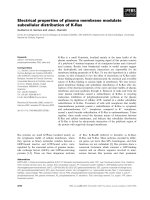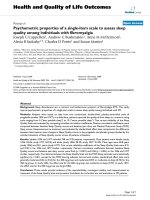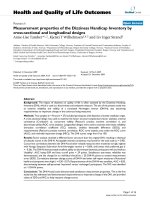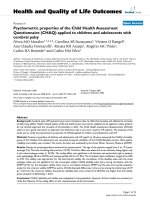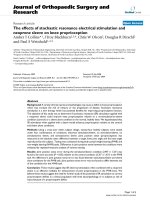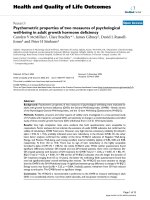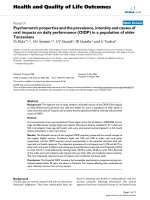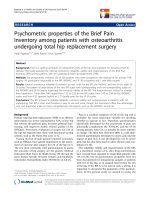Báo cáo hóa học: " Electrical properties of lead-free " pdf
Bạn đang xem bản rút gọn của tài liệu. Xem và tải ngay bản đầy đủ của tài liệu tại đây (373.32 KB, 12 trang )
This Provisional PDF corresponds to the article as it appeared upon acceptance. Fully formatted
PDF and full text (HTML) versions will be made available soon.
Electrical properties of lead-free 0.98(Na0.5K0.5)NbO3-0.02Ba(Zr0.52Ti0.48)O3
piezoelectric ceramics by optimizing sintering temperature
Nanoscale Research Letters 2012, 7:15 doi:10.1186/1556-276X-7-15
Seung-Hwan Lee ()
Sung-Gap Lee ()
Young-Hie Lee ()
ISSN 1556-276X
Article type Nano Express
Submission date 9 September 2011
Acceptance date 5 January 2012
Publication date 5 January 2012
Article URL />This peer-reviewed article was published immediately upon acceptance. It can be downloaded,
printed and distributed freely for any purposes (see copyright notice below).
Articles in Nanoscale Research Letters are listed in PubMed and archived at PubMed Central.
For information about publishing your research in Nanoscale Research Letters go to
/>For information about other SpringerOpen publications go to
Nanoscale Research Letters
© 2012 Lee et al. ; licensee Springer.
This is an open access article distributed under the terms of the Creative Commons Attribution License ( />which permits unrestricted use, distribution, and reproduction in any medium, provided the original work is properly cited.
Electrical properties of lead-free 0.98(Na
0.5
K
0.5
)NbO
3
-0.02Ba(Zr
0.52
Ti
0.48
)O
3
piezoelectric ceramics by optimizing sintering temperature
Seung-Hwan Lee
2
, Sung-Gap Lee
1
, and Young-Hie Lee*
2
1
Department of Ceramic Engineering, Engineering Research Institute, Gyeongsang National
University, Jinju-Si, 660-701, South Korea
2
Department of Electronic Materials Engineering, Kwangwoon University, Seoul, 139-701,
South Korea
*Corresponding author:
Email addresses:
S-HL:
S-GL:
Y-HL:
Abstract
Lead-free 0.98(Na
0.5
K
0.5
)NbO
3
-0.02Ba(Zr
0.52
Ti
0.48
)O
3
[0.98NKN-0.02BZT] ceramics were
fabricated by the conventional mixed oxide method with sintering temperature at 1,080°C to
1,120°C. The results indicate that the sintering temperature obviously influences the
structural and electrical properties of the sample. For the 0.98NKN-0.02BZT ceramics
sintered at 1,080°C to 1,120°C, the bulk density increased with increasing sintering
temperature and showed a maximum value at a sintering temperature of 1,090°C. The
dielectric constant, piezoelectric constant [d
33
], electromechanical coupling coefficient [k
p
],
and remnant polarization [P
r
] increased with increasing sintering temperature, which might
be related to the increase in the relative density. However, the samples would be deteriorated
when they are sintered above the optimum temperature. High piezoelectric properties of d
33
=
217 pC/N, k
p
= 41%, dielectric constant = 1,951, and ferroelectric properties of P
r
= 10.3
µC/cm
2
were obtained for the 0.98NKN-0.02BZT ceramics sintered at 1,090°C for 4 h.
Keywords: NKN-BZT; lead-free; sintering temperature; piezoelectric properties.
Introduction
Lead-based perovskites have been extensively used in industries as sensors, actuators, and
transducers due to their outstanding electrical properties. However, the PbO in these materials
presents an environmental problem. The studies are now focused on discovering an
alternative for lead-based materials. Potassium sodium niobate ((Na,K)NbO
3
) materials are
thought to be one of the candidates as substitute systems [1-3]. When hot-pressed,
(Na
0.5
K
0.5
)NbO
3
[NKN] ceramics have been reported to possess high phase transition
temperature [T
c
] (approximately 420°C), high remnant polarization [P
r
] (approximately 33
µC/cm
2
), large piezoelectric longitudinal response [d
33
] (approximately 160 pC/N), and high
planar coupling coefficients [k
p
] (approximately 45%) [4-6]. However, conventionally
sintered NKN ceramics show relatively lower electrical properties (d
33
= 70 pC/N, k
p
= 25%)
due to the difficulty of getting a high density of pure NKN ceramics [7]. To compensate for
these problems, NKN-based ceramics (e.g., solid solutions of NKN-LiNbO
3
, NKN-LiTaO
3
,
NKN-LiSbO
3
, NKN-Li(Ta,Sb)O
3
, NKN-BaTiO
3
, NKN-SrTiO
3
, NKN-Ba(Zr,Ti)O
3
, and
NKN-CaTiO
3
) have received significant attention largely for two reasons: (1) piezoelectric
properties exist over an extensive range of temperature and (2) several possibilities for
substitution and additions. Among them, Ba(Zr
0.52
Ti
0.48
)O
3
[BZT] ceramics possess very
strong piezoelectric properties (d
33
is approximately 236 pC/N) and ferroelectric properties
(P
r
is approximately 13 to 18 µC/cm
2
). BZT has the advantage of exhibiting improved
piezoelectric properties. However, it has a low Curie temperature (about 100°C), which limits
its practical application as a piezoelectric material. In view of the high Curie temperature of
NKN ceramics, the NKN-BZT binary system is of much value as a piezoelectric material [8-
12]. In this paper, we have fabricated a 0.98(Na
0.5
K
0.5
)NbO
3
-0.02Ba(Zr
0.52
Ti
0.48
) [0.98NKN-
0.02BZT] solid solution by a conventional ceramics technique, and the influence of sintering
temperatures on the dielectric and piezoelectric properties of the 0.98NKN-0.02BZT
ceramics was investigated.
Experiments
The chemical molecular formula used in this experiment for the perovskite ceramics with
(Na, K, Ba) complex A-sites and (Nb, Zr, Ti) complex B-sites is 0.98(Na
0.5
K
0.5
)NbO
3
-
0.02Ba(Zr
0.52
Ti
0.48
) ceramics. For specimens prepared by the conventional mixed oxide
method from Na
2
CO
3
, K
2
CO
3
, Nb
2
O
5
, BaCO
3
, ZrO
2
, and TiO
2
as the staring materials, these
powders were separately dried in an oven at 100°C for 4 h. They were ball-milled for 24 h
using zirconia balls in alcohol. After drying at 110°C for 24 h, the powders were calcined at
850°C for 5 h. The calcined powders were pressed into disk samples of φ = 12 mm. The
samples were sintered at 1,080°C to 1,120°C for 4 h. After the samples were polished up to
1.0-mm thick, Ag paste was screen-printed on the surfaces as electrodes and then fired at
400°C for 10 min. We used X-ray diffraction [XRD] and scanning electron microscopy
[SEM] to analyze the crystalline and microstructures. The dielectric properties were
measured using an LCR meter (PM6306, Fluke, Test Equipment Connection Corporation,
Lake Mary, FL, USA). Hysteresis loops of the samples were measured by a Sawyer-Tower
circuit. The samples were poled under a DC field of 4 kV/mm for 20 min. The d
33
was
measured by a d
33
meter (DT-3300, Channel Products Inc., Chesterland, OH, USA). The k
p
was calculated by measuring the antiresonance and resonance frequencies. The relative
density of the sintered samples was measured by the Archimedes method.
Results and discussion
The XRD patterns of 0.98NKN-0.02BZT ceramics with sintering temperatures were varied
from 1,080°C to 1,120°C as shown in Figure 1. As seen from these XRD patterns, the
0.98NKN-0.02BZT phase sintered at various sintering temperatures was well developed
without a second phase. It can be seen clearly in Figure 2 that the 0.98NKN-0.02BZT
ceramic had an orthorhombic phase that was not changed for all samples. The orthorhombic
phases are characterized by (200) and (020) peaks splitting at approximately 45.5°, and when
the sintering temperature was increased, the peak form is almost the same. These results
indicated that the 0.98NKN-0.02BZT ceramics with various sintering temperatures are
regarded to have an orthorhombic structure. However, the degree of crystallization of all
samples is completely different. The 0.98NKN-0.02BZT ceramics were well crystallized with
increasing sintering temperature. However, as the sintering temperature was increased above
1,090°C, the peak shape became flatter than that of 0.98NKN-0.02BZT ceramics sintered at
1,090°C. It can be inferred that 0.98NKN-0.02BZT ceramics sintered above 1,090°C lost
their well-developed orthorhombic structure. These structural results cause a decline of
electrical properties such as d
33
and dielectric constant.
Figure 3 shows the SEM images of the 0.98NKN-0.02BZT ceramics sintered at various
sintering temperatures. As shown in Figure 3a, 0.98NKN-0.02BZT ceramics sintered at
1,080°C showed a small average grain size, although a dense microstructure was formed. It
can be inferred that the grain growth was not completed due to low sintering temperature.
Figure 2b exhibits the SEM images of 0.98NKN-0.02BZT ceramics sintered at 1,090°C. The
cavities have been reduced, and the sample turns into a higher-density microstructure with an
increased average grain size. This is according to the kinetic grain growth equation expressed
as [13]:
0
1 1
log log log 0.434
Q
G t K
n n RT
= + −
where G is the average grain size at the time, n, the kinetic grain growth exponent, t, the
sintering time, K
0
, a constant, Q, the apparent activation energy, R, the gas constant, and T,
the absolute temperature. It can be inferred that increasing sintering temperature improves the
grain growth. However, with an increasing sintering temperature above 1,090°C, the
microstructure was inhomogeneous and the grain size becomes exceptionally huge. These can
be the reason for the deterioration of the relative bulk density over 1,090°C as shown in the
SEM images.
Figure 4 shows the temperature dependence of the dielectric constant as a function of the
temperature for 0.98NKN-0.02BZT ceramics sintered at various sintering temperatures. All
samples show transitional peaks and one-transition temperatures at Curie temperature [T
c
] of
the 0.98NKN-0.02BZT ceramics. The T
c
slightly, but not rapidly, decreased with increasing
sintering temperature. The T
c
for all samples sintered at 1,080°C, 1,090°C, 1,100°C, and
1,110°C is 406°C, 411°C, 417°C, and 421°C, respectively. The T
c
increased with increasing
sintering temperature owing to considerably increase the K ratio in the A-site of NKN
ceramics. This phenomenon of gradually increasing T
c
for the 0.98NKN-0.02BZT ceramics is
similar to that of the NKN system with an increasing K ratio. The dielectric constants
enhanced with increasing sintering temperature. However, when increasing the sintering
temperature above 1,090°C, the dielectric constant decreased. From this decreased dielectric
constant, it can be inferred that volatile Na and K ions were evaporated at the high sintering
temperature and relative bulk density was decreased. The maximum dielectric constant of
0.98NKN-0.02BZT ceramics is 1,951 sintered at 1,090°C.
Figure 5 shows the d
33
, k
p
, and relative density of the poled 0.98NKN-0.02BZT ceramics
sintered at various sintering temperatures. It is obvious that d
33
,
k
p
, and relative density have a
similar tendency as a function of sintering temperature. The d
33
,
k
p
, and relative density of
0.98NKN-0.02BZT ceramics sintered at 1,080°C are 201 pC/N, 0.33, and 88%, respectively
and peaked their maximum values, which are 217 pC/N, 0.41, and 97%, respectively. It can
be concluded that the promotion can be attributed to the increase in bulk density, lowering the
leakage current, and improving the poling process. With a further increasing sintering
temperature above 1,090°C, the piezoelectric properties and relative density decreased. It can
be explained that the samples start to heavily volatilize Na and K of 0.98NKN-0.02BZT
ceramics. The k
p
is calculated by the following equation [14]:
( )
r
2
a r
1 f
a b
k f f
= × +
−
where f
r
is the resonance frequency, f
a
is the antiresonance frequency, a = 0.395, and b =
0.674 for a planar (k
p
) mode. Figure 6 shows the ferroelectric properties of the 0.98NKN-
0.02BZT ceramics sintered at various temperatures. The P
r
is 5.8 µC/cm
2
and the coercive
electric field [E
c
] is 5.4 kV/cm for 0.98NKN-0.02BZT ceramics sintered at 1,080°C. When
the sintering temperature was increased up to 1,090°C, the well-saturated ferroelectric
properties were obtained, and the values of P
r
and E
c
of samples sintered at 1,090°C were
10.3 µC/cm
2
and 7.2 kV/cm, respectively. Continuously increasing the sintering temperature
above 1,090°C, the ferroelectric properties decreased due to heavy volatilization of Na and K
at high sintering temperature. The ferroelectric properties of 0.98NKN-0.02BZT ceramics
have a similar tendency as with the piezoelectric and dielectric properties. The increase of
ferroelectric properties might be caused by the increase of the relative bulk density that
reduces the leakage current, promoting the polarization process.
Conclusion
In conclusion, the lead-free 0.98NKN-0.02BZT ceramics with a perovskite structure have
been sintered at various sintering temperatures. The effects of the sintering temperatures on
the structural and electrical properties were investigated. Increasing sintering temperatures
improve the grain growth, densification, and electrical properties in effect. However, with an
increasing sintering temperature above 1,090°C, the structural and electrical properties have
significantly deteriorated. The obtained d
33
is 217 pC/N, which is the highest value in the
0.98NKN-0.02BZT system. The equivalent properties of T
c
, k
p
, P
r
, and dielectric constant
values are 411°C, 0.41, 10.3 µC/cm
2
, and 1,951, respectively. Therefore, 0.98NKN-0.02BZT
ceramics is a potential candidate for lead-free piezoelectric ceramics.
Competing interests
The authors declare that they have no competing interests.
Authors' contributions
S-HL carried out the experiments which show the electrical properties and drafted the
manuscript. S-GL carried out the experiments which show the structural properties and
reviewed the manuscript. Y-HL participated in the design of this study and reviewed the
manuscript finally. All authors read and approved the final manuscript.
References
[1] Hansen P, Hennings D, Schreinemacher H: High-K dielectric ceramics from
donor/acceptor-Co doped (Ba
1-x
Ca
x
)(Ti
1-y
Zr
y
)O
3
.
J Am Ceram Soc 1998, 81:1369.
[2] Lee SH, Lee YH: Piezoelectric and dielectric properties of (Na
0.44
K
0.52
)Nb
0.84
O
3
-
Li
0.04
(Sb
0.06
Ta
0.1
)O
3
ceramics with sintering temperature. Electronic Materials Letters
2011, 7:205.
[3] Nam SP, Lee SG, Bae SG, Lee YH: Electrical properties of (Bi,Y)
4
Ti
3
O
12
thin films
grown by RF sputtering method. J Electrical Engineering & Technology 2007, 2:98.
[4] Noh HJ, Lee SG, Nam SP: Dielectric and pyroelectric properties of Dy-doped BSCT
thick films by screen-printed method. J Electrical Engineering & Technology 2009,
4:527.
[5] Cho IJ, Yun KS Nam HJ: A high-speed single crystal silicon AFM probe integrated
with PZT actuator for high-speed imaging applications. J Electrical Engineering &
Technology 2011, 6:119.
[6] Matsubara M, Yamaguchi T, Kikuta K, Hirano S: Sinterability and piezoelectric
properties of (K,Na)NbO
3
ceramics with novel sintering aid. Jpn J Appl Phys 2004,
43:7159.
[7] Hollenstein E, Davis M, Damjanovic D, Setter N: Piezoelectric properties of Li- and
Ta- modified (K
0.5
Na
0.5
)NbO
3
ceramics. Appl Phys Lett 2005, 87:182905.
[8] Zhang SJ, Xia R, Shrout TR, Zang GZ, Wang JF:
Piezoelectric properties in perovskite
0.948(K
0.5
Na
0.5
)NbO
3
-0.052LiSbO
3
lead-free ceramics. J Appl Phys 2006, 100:104108.
[9] Bae HJ, J. K, Hong JP: Dielectric properties of Ti-doped K(Ta,Nb)O
3
thin films for
tunable microwave applications. J Electrical Engineering & Technology 2006, 1:120.
[10] Yuan GL, Or SW: Enhanced piezoelectric and pyroelectric effects in single-phase
multiferroic Bi
1-x
Nd
x
FeO
3
(x=0-0.15) ceramics. Appl Phys Lett 2006, 88:062905.
[11] Kim MS, Jeon YM, IM YM, Lee YH, Nam TH: Crystallization behavior of Ti-(50-
x)Ni-xCu(at%) (x=20-30) alloy ribbons. Trans Electr Electron Mater 2011, 12:20.
[12] Lee SH: Electromagnetic properties of Bi system. J Electrical Engineering &
Technology 2007, 2:102.
[13] Chen TY, Chu SY, Juang YD: Effects of sintering temperature on the dielectric and
piezoelectric properties of Sr additive Sm-modified PbTiO
3
ceramics. Sens Actuator
A Phys 2002, 102:6.
[14] Matsubara M, Yamaguchi T. Kikata K, Hirano S: Effect of Li substitution on the
piezoelectric properties of potassium sodium niobate ceramics. Jpn J Appl Phys
2005, 44:6136.
Figure 1. XRD patterns of 0.98NKN-0.02BZT ceramics.
Figure 2. XRD patterns of 0.98NKN-0.02BZT ceramics near the (020) and (200) planes.
Figure 3. SEM images of 0.98NKN-0.02BZT ceramics. (a) 1,080°C, (b) 1,090°C, (c)
1,100°C, (d) 1,110°C, and (e) 1,120°C.
Figure 4. Temperature-dependent dielectric properties of 0.98NKN-0.02BZT ceramics.
Figure 5. Piezoelectric properties and relative density of 0.98NKN-0.02BZT ceramics.
Figure 6. P-E hysteresis loops of 0.98NKN-0.02BZT ceramics.
20 30 40 50 60 70 80
(e) 1120
O
C
(d) 1110
O
C
(c) 1100
O
C
(b) 1090
O
C
(a) 1080
O
C
031
221
220
211
210
200/020
110
100
Intensity (arb. unit)
Diffr action angle [ 2 ]
Figure 1
43 44 45 46 47 48
(e) 1120
O
C
(d) 1110
O
C
(c) 1100
O
C
(b) 1090
O
C
(a) 1080
O
C
200
020
Intensity (ar b. unit)
Diffr action angle [ 2 ]
Figure 2
(a) 1080°C (b) 1090°C (c) 1100°C
(d) 1110°C (e) 1120°C
Figure 3
100 150 200 250 300 350 400 450 500
0
1000
2000
3000
Temper atur e (
o
C)
Dielectric constant (
r
)
1110
o
C
1100
o
C
1090
o
C
1080
o
C
Figure 4
1080 1090 1100 1110 1120
200
210
220
0.30
0.35
0.40
0.45
85
90
95
100
Sintering temperatur e(
o
C )
d
33
(pC/N)
k
p
Relative density (% )
Figure 5
-60 -40 -20 0 20 40 60
-40
-30
-20
-10
0
10
20
30
40
-60 -40 -20 0 20 40 60
-60 -40 -20 0 20 40 60
Electric Field (kV/cm)
-60 -40 -20 0 20 40 60
-40
-30
-20
-10
0
10
20
30
40
1080
o
C 1100
o
C 1090
o
C
1120
o
C 1110
o
C
Polariztion C/cm
2
Polariztion
C/cm
2
-60 -40 -20 0 20 40 60
Figure 6
